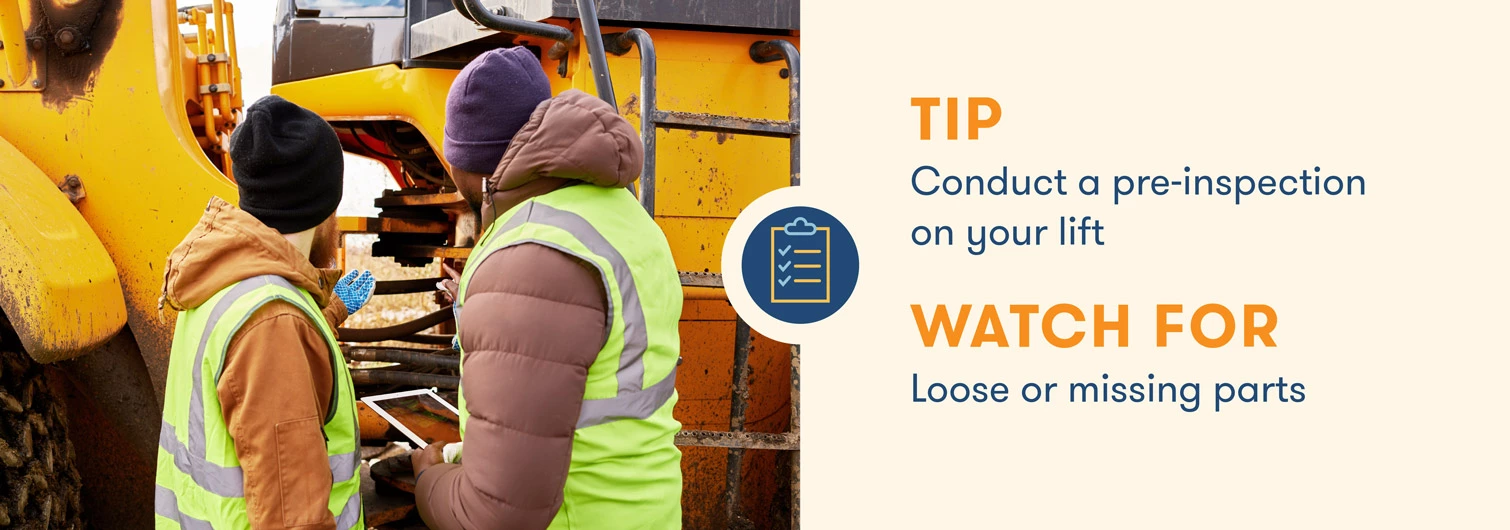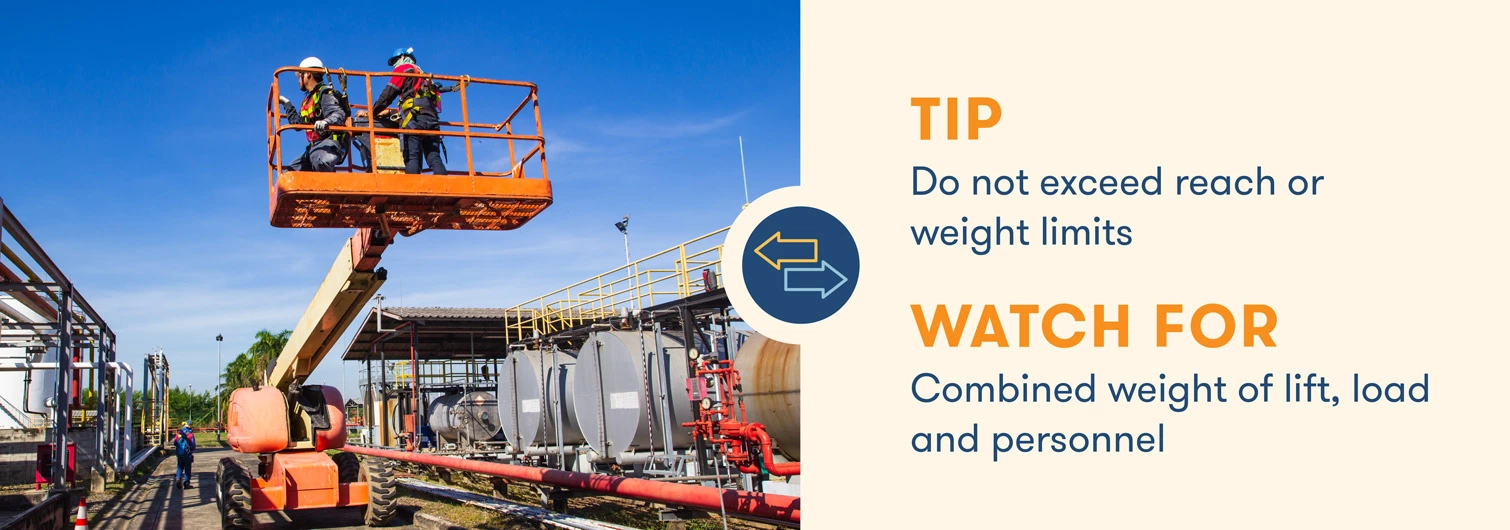Aerial lifts are vehicle-mounted devices with extendable platforms used to elevate personnel. These lifts are great for accessing high job sites like roofs and HVAC equipment, and they are an ideal alternative for hard-to-reach projects where scaffolding isn’t the best option. It’s essential, however, to keep safety top of mind when operating these machines.
Aerial lift safety is of the utmost importance. A great way to start incorporating safety into your workday is to go through an aerial safety checklist. To prepare you and your team, take a look at our guide for a list of common site safety hazards, information about certifications and tips to stay out of harm’s way
1. Verify That Operators Are Trained and Certified
Only those who are trained and certified are allowed to operate a lift. Confirm that your employees’ certifications are up to date and that they’re familiar with the manufacturer guidelines for each lift they will operate.
2. Review Every Part of the Vehicle and Lift Prior to Operation
Take some time to inspect every single part of the lift before operating. Begin with the vehicle itself by checking fluid levels, including oil, hydraulic, fuel and coolant. Other things to check include the battery, charger, wheels, tires, horns, lights and backup alarms.
You should also ensure that all hydraulic, air and electrical systems are functioning, as well as all operating and emergency controls. Look for any loose or missing parts, missing or unreadable operational or instructional placards or markings that need to be replaced. You should also test the lift to ensure it’s functioning properly prior to loading it with any personnel or supplies.
3. Inspect the Surrounding Work Area for Hazards
A safe work zone is just as important as safe machinery. When working indoors, you should examine the ceiling to make sure it’s an adequate height and identify any potential overhead hazards. You should also examine the floor and surrounding area for unstable surfaces, bumps or anything else that could cause an obstruction.
When working outside, inspect the surrounding area for any drop-offs, holes, ditches, slopes, debris or other floor obstructions that need to be cleaned up or avoided. You should also take note of nearby overhead electrical lines and communication cables. High winds and severe weather conditions that could endanger your employees are also major hazards to watch out for.
4. Don’t Override Safety Features for Any Reason
Any temporary convenience (like moving equipment more quickly) is not worth the increased potential for accidents. By overriding safety features, you could risk extending the lift too far or operating at dangerous speeds.
5. Stay Attentive to Your Surroundings
A good rule of thumb is to always treat lines, wires and other conductors as energized even if they are down or appear insulated. If you can’t completely avoid power lines, you should stay at least 10 feet away to prevent possible accidents. You should also avoid positioning aerial lifts between power lines and other overhead hazards when possible.
6. Refrain From Surpassing Reach and Weight Limits
Take the time to calculate weight before loading and operating your aerial lift. When doing this, remember to take into account the combined weight of the operator, tools and materials. Always adhere to weight and reach limits set forth by the manufacturer to avoid tip-overs.
7. Don’t Lean, Sit or Climb on the Edge of the Bucket or Platform
Guardrails are meant to protect workers from falling and should not be used to climb or sit on. Doing so puts employees at risk of falling and the lift at risk of tipping. Although it’s tempting to reach over to something slightly out of reach, it’s safest to lower the lift and move the entire machine a few feet than to risk a serious injury.
8. Use Outriggers, Brakes and Wheel Chocks When Possible
Outriggers and brakes add a layer of stability to prevent any unexpected shifts in the ground or the lift. These should be used even if the ground seems stable at first glance. Wheel chocks are essential for ensuring your lift stays in place when working on inclines.
9. Don’t Put Scaffolding on the Aerial Lift Platform
Adding scaffolding to the platform or bucket can greatly increase your risk of falling. You should avoid this even if the scaffolding falls under weight capacity limits.
Scissor lifts have a distinct set of hazards to look out for thanks to their shape and potential height. Their ability to extend vertically combined with the ability to move horizontally can cause problems if you don’t operate with caution. Read on to see what you should do to stay safe while operating a scissor lift.
10. Keep Scissor Lifts Away From Other Equipment
Clear the surrounding area of other equipment when operating scissor lifts. These lifts can potentially tip if they bump into another piece of equipment, so you should always leave plenty of room to operate.
11. Don’t Move a Scissor Lift in an Upright Position
<
Employees should completely lower a scissor lift before moving unless otherwise stated by the manufacturer’s manual. Moving a scissor lift even slightly while it is elevated can put the lift at risk of tipping over.
Boom lifts also have unique safety precautions due to their design. Their range of motion creates a handful of potential hazards to keep your team aware of in the field. Check out a few of these boom lift safety tips below.
12. Wear a Full-body Harness or Restraining Belt
The risk of falling is elevated in a boom lift since it moves forward and backward in addition to moving up and down. Before moving the lift, make sure you are secured with a harness or belt and check for old or worn restraints.
13. Clear People From the Base and Surrounding Area
A boom lift’s range of motion offers more chances to injure someone in the surrounding area. Clear the entire circumference of the boom lift’s reach prior to starting any work and set up work zone warnings to keep the area clear.
14. Don’t Use a Boom To Lift Overweight Objects or Supplies
Since boom lifts are only meant to lift people and tools, refrain from loading them with any weighty objects or supplies. This puts the lift at risk of tipping and puts the entire team at risk of injury.
Common Aerial Lift Hazards
The heights that aerial lifts reach create dangerous situations unique to these machines. For example, strong winds are dangerous working conditions for aerial lifts since winds have the potential to tip over an aerial lift. Here are some common hazards to look out for:
- Personnel or objects falling
- Tip-overs
- Structural failures
- Electrocutions
- Entanglement
- Contact with objects, ceilings, and other overhead obstructions
Knowing basic boom lift safety tips, manlift operating precautions and how to safely operate other types of aerial lifts is important since each lift differs in functionality and potential safety hazards. For example, boom lifts can tip over if they’re too top-heavy or if they’re on uneven ground. This is rare, but important to keep in mind when you’re out in the field.
Training Tips for Aerial Lift Operators
As we mentioned, only trained and certified aerial lift operators should operate these lifts. Keep in mind that different lifts may require different certifications to operate. These certifications need to be renewed at least every three years and sometimes more frequently depending on a few different factors. These include:
- Aerial lift-related safety risks are found in the work area.
- Accidents occurring while operating an aerial lift.
- An operator is seen inappropriately using the lift.
- A new type of aerial lift is used.
Keep these aerial lift safety tips handy the next time your team is handling boom or scissor lifts. Proper training, adequate pre-inspections and heightened awareness at all times are the best ways to keep you and your team safe. To learn even more ways to improve work zone safety, take a look at our collection of safety articles.
























